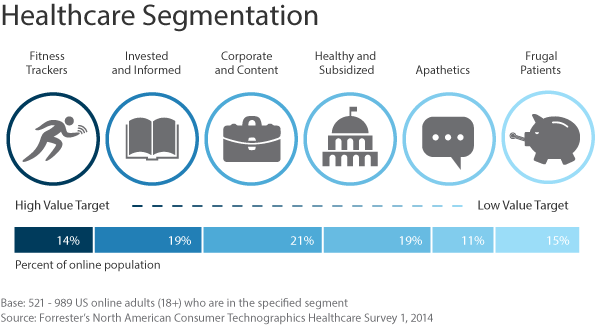The Data Digest: Introducing Forrester’s Consumer Healthcare Segmentation
The age of the customer coupled with the onset of the Patient Protection and Affordable Care Act (a.k.a. "Obamacare") means that many new customers will enter the US health insurance market. One outcome of the legislation is an opportunity for health insurance marketers to acquire new customers and engage existing customers — and Forrester wants to help them seize this moment. As such, we have created a consumer healthcare segmentation to identify unique groups of US consumers as well as their healthcare needs and attitudes to help health insurance marketers target new customers, engage existing customers, and innovate exciting healthcare tools and programs.
Our report, “Introducing Forrester’s Consumer Healthcare Segmentation,” explains each segment and how to attract or engage them. The segmentation includes both insured and uninsured consumers, representing the entire US online adult population. The graphic below shows each of the segments and their relative size.

Some highlights from the report, which is based on a survey of more than 4,500 US online consumers:
- Fitness Trackers are young and love to use wearable devices; in fact, everyone in this segment uses one. The majority agree that that their health and wellness are priorities for them and they try to eat a healthy diet, but close to half believe that they are so healthy that they don’t need health insurance.
- The Invested And Informed have high incomes and are willing to pay more for better care. They also do their homework when it comes to their healthcare: 81% are confident of their ability to make the right choices with regard to their health benefits, and seven in 10 consider themselves a health decision-maker for their family or household.
- The Corporate And Content have relatively high average household incomes, but they're still not willing to pay more for a health plan with better benefits. They also represent the highest share of members covered through a family member’s plan.
- The Healthy And Subsidized are mostly covered through the government, although a quarter have direct access (i.e., they pay all costs out of pocket). Almost half of them are considered low-income, and only 6% suffer from a chronic or serious condition.
- Apathetics are uninsured and healthy. They have lower incomes and are generally uneducated about their options. They’re the group least likely to have received any medical care, and they’re not confident of their ability to make the right choices with regard to their health benefits.
- Frugal Patients suffer from a serious or chronic condition; they are the segment most likely to be obese; and they are the oldest. They consume a lot of medical care: Not only have 92% visited a doctor’s office in the past year, but 37% have been to the ER.
As this segmentation includes both healthcare- and nonhealthcare-related variables, it reveals unique opportunities for health insurance and healthcare marketers to attract and engage with existing and new clients. The need for tracking devices and constant feedback for some of these segments also offers nonhealth companies an entry point into this market. Feel free to reach out if you want to know more.
Forrester's Consumer Technographics clients can read the report here.